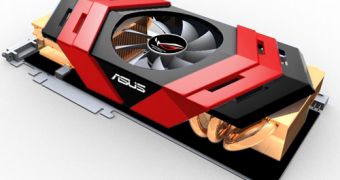The 4GB ATI Radeon HD 5970 model known as ARES has been in development at ASUS for a while now. Unsurprisingly, the hardware maker's rivals were not slow in devising their own models, even showcasing them at this year's edition of the CeBIT expo in Hanover, Germany. Now joining Sapphire and XFX, ASUS has made the official announcement of the Republic of gamers adapter, which, the company says, “goes where none have ventured before.” Still, in order to raise the stakes, the company has showcased not just this one, but also a second video controller, namely the MATRIX 5870.
The specs of the ARES were detailed last month and showed two 8-pin PCI Express power connectors, a GPU clock of 825MHz, a memory clock of 4800MHz and an interface of 2x256 bits. The number of stream processors was of 3,200. The official press release states that the new version of the dual-GPU card has a performance 23% better than that of the stock model and an airflow increase of 600%. This normally means that the adapter should produce a legendary level of noise, but the company assures its customers that, in fact, the noise level is actually lower than that of the reference card.
The second card demonstrated at CeBIT is the MATRIX 5870 with 2GB GDDR5. Described as “another beastly overclocking hero,” the card can boost its performance by up to 19% during gaming, through the use of the hybrid Engine optimization. The card comes with the Extreme Cooler, which has real-time fan speed adjustment and is very quiet when idle. Furthermore, by employing the iTracker2 software, users can adjust memory timing. This is all enabled through the press of a single, safe-mode button.
While the press release didn't contain any specifics, the MATRIX reportedly has a GPU frequency of 894MHz and a memory clock of 4800Mhz. The ARES will be a limited production run, which means that models will be rare even immediately after they become available. Still, considering the likely massive price, there will not be many users that will afford it. The same can be said about the MATRIX, although this unit will be available in a higher number of models. The cards' exact availability is still undisclosed, but, considering that their development is, more or less, complete, they should appear in the second quarter.

 14 DAY TRIAL //
14 DAY TRIAL //